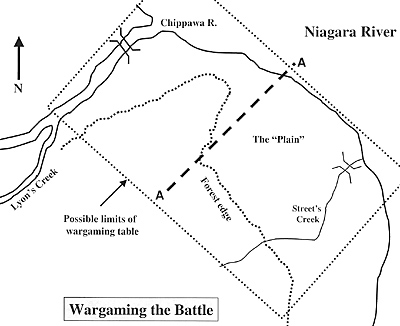 Chippawa, like many War of 1812 battles, is fun to wargame because of the variety of units. On the British side there are British regulars, Canadian militia, and western Indians, the remnants of Tecumsehís failed confederacy. On the American side are regulars in both gray jackets and blue coats, volunteers in civilian dress, and the Seneca in a mix of native and white garb. The units varied in level of training and experience which can lead to a wide variety of results on the battlefield.
Chippawa, like many War of 1812 battles, is fun to wargame because of the variety of units. On the British side there are British regulars, Canadian militia, and western Indians, the remnants of Tecumsehís failed confederacy. On the American side are regulars in both gray jackets and blue coats, volunteers in civilian dress, and the Seneca in a mix of native and white garb. The units varied in level of training and experience which can lead to a wide variety of results on the battlefield.
Order of Battle
Note: numbers have been rounded.
British Major General Phineas Riall commanding
- 1st Regt. of Foot, the Royal Scots, Lieutenant Colonel Gordon (500)
8th Regt. of Foot, the Kingís Regt., Major Evans (420)
100th Regt. of Foot, Prince Regentís Dublin Regt., Marquis of Tweedale (400)
Battalion of Light Infantry, Lieutenant Colonel Pearson (150)
2nd Lincoln Militia Regt., Lieutenant Colonel Dickson (300)
Troop 19th Light Dragoons, Major Lisle (50)
Artillery, Captain Mackonochie (50): Two 24#, One 5 1/2 inch howitzer, and Three 6#
Natives Allied to British
- Grand River Indians, Norton, (150)
Western Indians, (150)
Americans Major General Jacob Brown commanding
- First Brigade, Brig. Gen. Winfield Scott
- Combined 9th/22nd Infantry, Major Leavenworth (570)
11th Infantry, Colonel Campbell/Major McNeil (420)
25th Infantry, Major Jesup (350)
Second Brigade, Brig. Gen. Eleazar Ripley
- 21st Infantry (including companies from the 17th and 19th Infantry), Lieut. Col. Miller
23rd Infantry, Major McFarland (350)
Third Brigade, New York Militia Brig. Gen. Peter B. Porter
- 5th Pennsylvania Volunteers, Colonel Fenton (500)
Company New York Mounted Rifles, Captain Boughton (150)
Allied Iroquois Indians, Red Jacket (550)
Troop Light Dragoons, Captain Harris (60)
Artillery, Lieut. Col. Hindman (320): Organized in four companies with a total of 15 guns.
Sequence of Troops Entering the Battle
It is clear that the Americans outnumber the British and will win handily if all troops are on the battlefield from the beginning. Therefore, it is best to phase in the Americans in the historical sequence if not on the exact schedule. The western Indians can be placed anywhere in the forest. The rest of Riallís force must be south of the Chippawa but north of line A-A. After the British are on the board, the Americans can set up Porterís Brigade and Scottís Brigade anywhere outside of the forest and south of Streetís Creek. These troops were assembled and ready to move when the British were first sighted entering the Plain. However, Ripleyís Brigade was not ready to move when the battle started. There are many ways to delay the entrance of Ripleyís Brigade.
For example, they must remain south of Streetís Creek until American forces have crossed line A-A. As for American artillery, one company of three guns can move with Scottís Brigade. One company can move when all of Scottís Brigade is north of Streetís Creek. The last two companies can move when Ripley moves.
Victory Conditions
This is the hardest part of the wargame. If Riall really knew what he was up against, being outnumbered by some fairly well trained and motivated troops, itís hard to believe that he would still come out from behind the Chippawa River. In the historical fight, his goal was to destroy a smaller part of the American Army before the larger part of it arrived. The American goal was to destroy Riallís force if possible but certainly to get the Left Division across the Chippawa River. However, if we assign historical goals we wonít have much of a fight on the Plain or in the forest. Riall will remain in his entrenchments north of the Chippawa.
In order to set up conditions that lead to a fight on the Plain, we need to modify the victory conditions. The battle lasted about five hours in the daylight. Check your rules for how long that is. At fifteen minutes a turn, that would be twenty turns. These conditions should provoke a fight on both the Plain and in the forest.
British major victory There are two options to score a major British victory. At the end of daylight hours, no American forces remain on the Plain. Or, the Americans and their native allies suffer 20 % more casualties than British and allied natives. Measure casualties in absolute numbers of figures eliminated from the board.
British marginal victory British have some forces (at least the equivalent of 400 persons) south of the Chippawa at the end of daylight hours and have inflicted casualties on the Americans at least equal to the number of casualties suffered.
American major victory At the end of daylight hours, no British remain south of Chippawa River and Americans have inflicted at least 30% more casualties on the enemy than they have received.
American marginal victory At the end of daylight hours, no sizable British force (at least the equivalent of 400 persons) remains on the Plain and Americans have inflicted at least 20% more casualties on the enemy than they have received.
More Featured Battle: Chippawa 1814
- The Battle of Chippawa
Brownís Official Chippawa Report
Riallís Official Chippawa Report
Porterís Statement
Wargaming the Battle of the Chippawa
Back to Table of Contents -- War of 1812 #3
Back to War of 1812 List of Issues
Back to MagWeb Magazine List
© Copyright 2002 by Rich Barbuto.
This article appears in MagWeb (Magazine Web) on the Internet World Wide Web.
Other military history articles and gaming articles are available at http://www.magweb.com